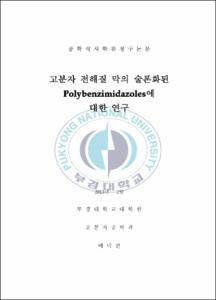고분자 전해질 막의 술폰화된 polybenzimidazoles에 대한 연구
- Alternative Title
- Synthesis of sulfonated polybenzimidazoles for polymer electrolyte membrane
- Abstract
- We need new energy sources due to a problem with the acceleration of exhaustion of natural resources. A fuel cell can is one of the alternative energy to solve such problem. A fuel cell can be divided into several types according to its operating temperature, electrolyte, or moving conductive ions through an electrolyte. Among such fuel cells, the Polymer electrolyte fuel cells (PEMFCs) is paid attention to wide and potential applications such as a portable electric device, an automotive and housing purposes, etc. Today, studies about proton conductive polymer membranes used to a polymer electrolyte fuel cell are concentrated in perfluoro-type electrolyte membrane such as Nafion that has high proton conductivity, an excellent chemical stability and a mechanical property. However, the use of such membrane is limited owing to high manufacturing costs, proton conductivity reduction at high temperature, etc.
The development of new polymer electrolyte membrane with proton conductivity is essential for overcoming such drawbacks, so studies are focused on the development of hydrocarbon electrolyte membrane that have the ability to operate at high and low temperatures and low costs for these replacements. These polymeric materials have a great variety of chemical structure and the ability to modify chemical structure easily with low costs. I have synthesized poly-benzimidazole with good mechanical properties and thermochemical stability through many ways and investigate a possibility as electrolyte membrane by sulfonating polymerized results.
- Issued Date
- 2013
- Awarded Date
- 2013. 2
- Type
- Dissertation
- Publisher
- 부경대학교
- Alternative Author(s)
- Bae, Deok Gwun
- Affiliation
- 부경대학교 대학원
- Department
- 대학원 고분자공학과
- Advisor
- 민성기
- Table Of Contents
- Ⅰ. 서론
Ⅰ-1. 연료 전지의 이해
Ⅰ-2. 연료 전지의 역사
Ⅰ-3. 연료 전지의 기본 원리
Ⅰ-4. 연료 전지의 종류
Ⅱ. 고분자 전해질 막 연료 전지 (PEMFC)
Ⅱ-1. 서론
Ⅱ-2. 높은 작동 온도가 필요한 이유
Ⅱ-3. 고분자 전해질 막 연료 전지 (PEMFC)
Ⅱ-4. 대체 전해질 막의 개발 현황
Ⅱ-4-1. Sulfonated aromatic 고분자 전해질 막
Ⅱ-4-2. Alkylsulfonated aromatic 고분자 전해질 막
Ⅱ-4-3. Acid-base 고분자 복합체를 이용한 고분자 전해질 막
Ⅱ-5. Polybenzimidazole의 합성
Ⅱ-5-1. 서론
Ⅱ-5-2. PBI를 이용한 막
Ⅱ-5-3. PBI 막 제조
Ⅱ-5-4. DS (Degree of sulfonation)
Ⅲ. 실험
Ⅲ-1. 시약 및 재료
Ⅲ-2. 사용 기기
Ⅲ-3. PBI 합성 및 실험
Ⅲ-3-1. SOPBI의 합성
Ⅲ-3-2. p-PBI의 합성
Ⅲ-3-3. s-PBI의 합성
Ⅳ. 결과 및 고찰
Ⅳ-1. DS (Degree of sulfonation) 분석
Ⅳ-2. 열안정성 분석
Ⅳ-3. 구조 분석
Ⅳ-4. 기타분석
Ⅳ-4-1. XRD 분석
Ⅳ-4-2. XPS 분석
Ⅴ. 결론
References
- Degree
- Master
- Files in This Item:
-
-
Download
 고분자 전해질 막의 술폰화된 polybenzimidazoles에 대한 연구.pdf
기타 데이터 / 1.76 MB / Adobe PDF
고분자 전해질 막의 술폰화된 polybenzimidazoles에 대한 연구.pdf
기타 데이터 / 1.76 MB / Adobe PDF
-
Items in Repository are protected by copyright, with all rights reserved, unless otherwise indicated.